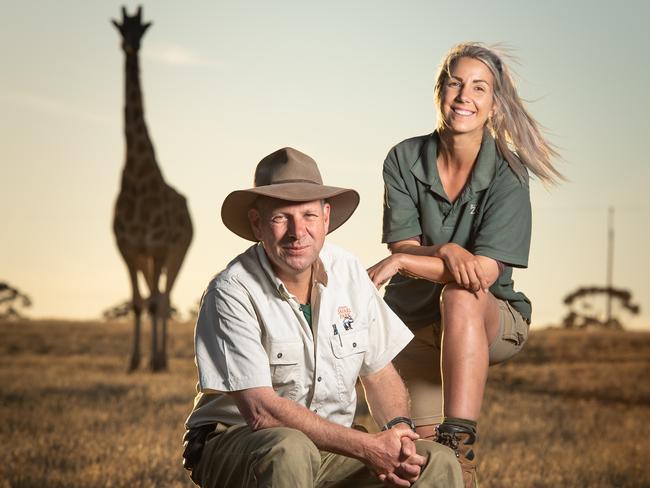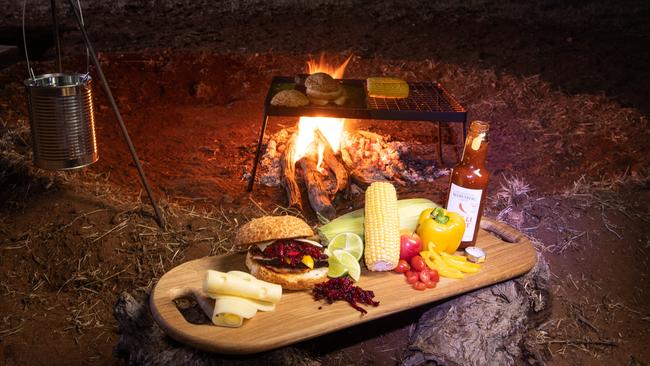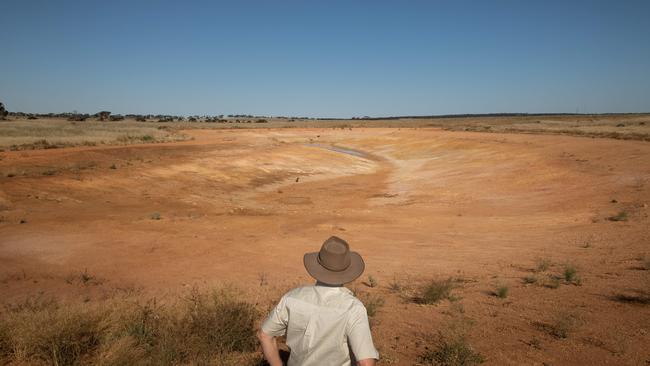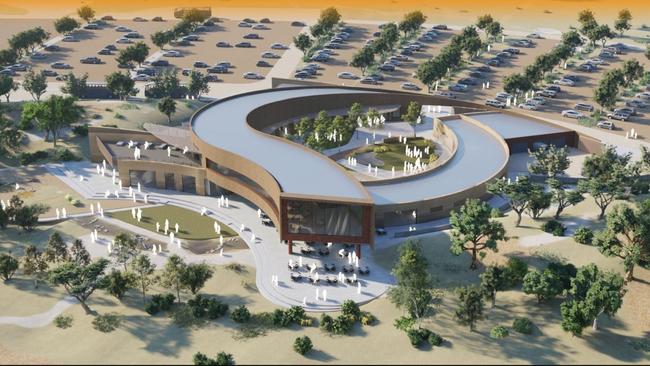The multimillion-dollar plan to bring Africa to Adelaide
It is a vision that’s so big, so ambitious, it’s Africa-sized — but Monarto Safari Resort is unperturbed. In an exclusive, SA Weekend reveals how plains in Adelaide’s east will become the world-leading facsimile for the Serengeti.

SA Weekend
Don't miss out on the headlines from SA Weekend. Followed categories will be added to My News.
- Monarto Zoo set for a $40 million five-star upgrade
- Monarto Zoo giraffe calf born to Korongo, joins growing herd
It’s just before 6am and magnificent orange hues are gradually encasing the eastern horizon as the sun announces its arrival on a landscape of grasslands and Mallee woodland.
A flickering campfire emits almost identical colours as the sunrise and flames flicker around a billy, hung from a tripod, gradually warming water for morning coffees. Before long, bacon and eggs are crackling on a hotplate fuelled by coals from the same fire.
SA Weekend is camping in Monarto Safari Park, and the sound of our cooking breakfast is almost drowned out by the cacophony of birds awaking to greet another Murraylands morning.
The lions are quiet this morning, but they were loud last night, their roars echoing for kilometres across the neighbouring plains.
They’re a pride of eight and are usually fairly content, but their bellowing pre-dawn growls are a regular wake-up call on the grass-covered savanna, providing music to the soul for the early-morning workers at Monarto.
It’s a spine-tingling melody which is about to become much more accessible to the general population, as the safari park, about 60 kilometres southeast of Adelaide, prepares for the most significant development in its 26-year history.
Monarto is already the largest open-range zoo in Australia but by 2022 will become the largest safari park outside of Africa.
Guests will stay overnight in luxury accommodation and awake to sights and sounds more commonly associated with places like Kruger National Park in South Africa.
Herds of animals – ranging from giraffes to zebras to rhinoceros to antelope – will graze on hectares of tall wheatgrass and drink from freshly-made waterholes as guests soak up the ambience sipping on lattes or gin and tonics – depending on the time of day.
It’s a vision which has been years in the making, but is now on the fast-track to completion thanks to a Victorian businessman and his $40 million investment.

Jayco Australia founder Gerry Ryan will build a five-star luxury resort and glamping facility on Monarto’s Wild Africa area – a 550-hectare slab on the eastern border of the current 1000-hectare zoo.
It’s a piece of land Zoos SA, the not-for-profit charity which runs both Monarto and Adelaide Zoo, first purchased back in 2009 and has been gradually developing.
Wild Africa project manager Tim Jenkins has been there from the start and knows his workload is about to be fast-tracked now that news of the accommodation has become public.
Initial modelling predicts the construction of the resort buildings will create 72 direct and 151 indirect full time jobs and generate $20.4 million worth of economic activity.
But Mr Jenkins has a staff of just four (plus a handful of volunteers) helping him transform the landscape on which the resort will sit – preparing it for the animals which will soon call it home.
The new, exciting prospect of what the park will eventually become and the tourists it will attract makes Mr Jenkins’ 6am starts worthwhile.
“It’s huge. It’s great to be involved,” he says.
“It’s a great feeling to say that we are literally on the ground building the largest safari park in the world outside of Africa.”
“At the same time, it’s daunting and a little bit scary because we’ve been really busy up until now and I can imagine that it’s only going to get a lot busier in the coming years as we get it ready to be open to the public.”
Each member of the team has to be everything from trench digger to welder to park manager to fence builder to pest control expert as they perform tasks ranging from digging and landscaping new waterholes to welding together the world’s largest walk-through lemur exhibit.
“In developing this site, there’s obviously a lot of different aspects to it,” Mr Jenkins says as we walk through the new lemur facility. “There’s not only the building and construction side, but we’ve also got all of the land management activities as well.
“We do all the pest control and weed control and the revegetation and regeneration work. But we’ve also got to have skilled people who can build structures like this – the new lemur facility.
“And this is just one of four major projects that we are working on at the moment.”
Mr Jenkins and his team are also creating a large rhino management and quarantine area, a main raceway to carry animals to different areas of the park and a perimeter security fence. Much of what they are building and carving into the landscape has never been done before, so they are learning every step of the way and make modifications on the run.
The Wild Africa area will boast four main paddocks, separated by hidden fencelines and electric grids, so that visitors will be able to enjoy a 20-kilometre, non-stop safari in special open-air vehicles without seeing any man-made infrastructure.
“Yes, there’ll be fences, but we have to cleverly hide these amongst the remnant vegetation and revegetation and painting and so-forth, just to try and hide them and blend them into the environment.
“So yes, they’ll be there, but unless you’re really looking for them, you’re not going to see them, you’ll be watching animals running around.”
Visitors will embark on tours lasting between two to three hours, sometimes being dropped of in oases of isolated, fenced-off patches of vegetation surrounded by granite boulders and viewing areas over the animals.
At some viewing areas, chefs and hospitality staff will be waiting to serve.
Evening safaris will stop on high ground overlooking the western horizon, and as the sun sinks over Mount Barker, guests will be served food and drinks as they watch the animals roam around the waterholes.

This is a vision shared by Victorian businessman Gerry Ryan, who visited Monarto for the first time less than three years ago while he was in South Australia for his annual visit for the Tour Down Under.
A long-time supporter of cycling, Mr Ryan is the major financial backer of Australian professional road racing team Mitchelton-Scott, and was chewing the fat with renowned cycling commentator Phil Liggett one day.
Liggett had just returned from Monarto, and had been particularly impressed with the park’s rhinoceros breeding program.
“They’re doing wonderful things,” he told the multi-millionaire, and urged him to pay a visit.
“So, one Sunday morning, I drove out … and went through the rhino program and looked around,” Mr Ryan recalls. “So I thought I’d write a cheque out, which I did, and we got talking.”
Mr Ryan discussed Zoos SA’s long-term goals with chief executive Elaine Bensted and he agreed Monarto had the potential to be the biggest safari park outside of Africa.
“I said that you’ve got to look at the potential of international tourist accommodation, conferencing and broaden your views and your vision,” he says.
“By bringing people out there and staying there you can then offer tours and more than just selling the land to a developer.
“You’ve got a long-term income coming off more visitors to the park and adding value to the ticket by doing tours.
“So we got talking and started this concept and I think that this just adds another dimension to South Australian tourism.”

Mr Ryan and his team are now in the process of drawing up designs for the resort, hope to lodge plans with Murray Bridge City Council early next year and open doors to guests by 2022.
He has been a regular visitor to the site in the past few weeks and is glowing in his praise of both what the Wild Africa site has to offer and the passion of the park’s leadership.
“Looking back on the property … it is going to be spectacular,” he says. “When they get the animals onto some of the new part where the hotel is going to be … it will be the largest safari park outside of Africa.
“It’s pretty special. It’s a very special project and I’m looking forward to the next couple of years having it up and running.”
Mr Ryan’s accommodation options at Wild Africa include a luxury resort with 80-90 hotel rooms, restaurants, bars, conference and function spaces, a children’s playground, day spa and large swimming pool.
There will be to 30 high-end glamping tents, each with their own ensuite, private deck and possibly even plunge pool, all serviced by chefs and hospitality staff at the resort.
Moats and invisible fences will surround the accommodation so guests will have an uninterrupted view of animals roaming around the plains and waterholes.
Perhaps unsurprisingly for a man who made his fortune building caravans, Mr Ryan also plans build a caravan park at the Safari Park once the resort is up and running.

He has promised to have the resort open by 2022, about the same time as a new $16.8-million visitor centre opens its doors on the northern end of the existing park.
The new centre, funded by state and federal government grants, will coincide with the park’s main entrance moving from the Old Princess Highway, which runs along its southern edge, to Monarto Road on the opposite boundary.
This simple change will force more adjustments, because bus tours and walks will start by heading in a different direction. Park director Peter Clark is investigating broadening guests’ transportation options to include self-drive tours between exhibits, extended walking trails and even dedicated cycling tracks.
The Wild Africa experience is the big ticket item on Monarto’s future, but Mr Clark also has plans for new exhibits and catering facilities throughout the original zoo. He is proud of what the park already offers and passionate about what it is about to achieve.
Speak to anyone at Monarto, and one of the first things they mention is the size of the property. The lion enclosure alone is large enough to house the Adelaide Zoo, with room to spare. Every zoo in Australia and New Zealand, including open range zoos, would fit into the entire Monarto resort.
“Monarto is a great place to work,” Mr Clark says. “We have a very good crew of people here that all love being here.
“Our keeping staff are probably a little bit more independent than what they are in a lot of other places because of the space they have to move around. It’s a different situation here, I guess, than what you would find in a normal zoo.
“And Monarto is still quite a raw site. I think that’s part of its charm. For example, our tracks in Wild Africa won’t be bitumised, we want to keep some of that African and Outback Australia type of atmosphere going.”
Monarto works closely with other zoos across Australia and New Zealand, sharing studs for breeding and moving animals between properties to ensure the best genetic mix.
The size of Monarto lends itself to housing larger animals, and the South Australian property is scheduled to be home to the largest herd of rhinos in the nation within in the next four years.
To combat the numbers of white rhino falling victim to poachers in Africa, a consortium of zoos has developed a plan to eventually house about 120 of the species in Australia and New Zealand. Monarto’s Wild Africa will be home to between 30 and 40 of this number.
“People keep trying (to stop the culling of rhinoceros) but the price poachers can get for the horn is just ridiculous,” Mr Clark says. “So what we’re doing is trying to build up the numbers over here as an insurance population.”

Extra income from the Wild Africa accommodation experience will flow towards the cost of securing and housing so many rhinos – and many other conservation projects supported by Zoos SA.
Mr Clark harbours dreams of introducing hippopotamuses in the not-so-distant future – an animal traditionally difficult to keep and breed in Australia. The hippos would join the white rhinos, black rhinos, zebras, giraffes, hyenas, cheetahs, lions chimpanzees, meerkats, Tasmanian devils, yellow-footed rock wallabies, American bison, African painted dogs and various antelope species who already call the area home.
The cost of accommodation for humans to stay at the new Monarto resort will include a bed tax, which Zoos SA will funnel into its conservation fund – a pool of cash set aside to finance numerous projects in SA, across the nation and oversees.
Zoos SA currently has 13 native conservation priorities: Pygmy blue-tongue lizards, yellow-footed rock wallabies, Mallee emu-wrens, black-flanked rock wallabies, western swamp tortoise, orange-bellied parrots, Tasmanian devils, striped legless lizards, south eastern red-tailed black cockatoos, plains wanderers, mainland tammar wallabies, rewilding for conservation and conserving Monarto’s threatened plant and woodland birds.
It also supports projects further afield including Wildlife Asia, Tetepare Island, Tacugama Chimpanzee Sanctuary, Cheetah Conservation Fund, the Painted Dog Conservation, South African National Parks rangers, Sera Wildlife Conservancy, China Wildlife Conservation Association, Wild Welfare, Giraffe Conservation Foundation, Komodo Survival Project and wildlife trade monitoring network TRAFFIC.
Zoos SA chief executive Elaine Bensted says the extra visitors the Wild Africa development brings to Monarto will help the organisation “significantly increase” its conservation investment.
“It will also allow us to connect with more people, because it will bring in a whole different audience,” she says. It will also generate more revenue, some of which will flow back to the ageing Adelaide Zoo.
Annual Monarto visitor numbers have risen from 25,000 to 160,000 in the past 20 years and Ms Bensted expects this to grow to 250,000 in the next five years.
So the heat is on Tim Jenkins and his small team to deliver a world-class safari experience.
They’ve already planted about 50,000 trees, creating vegetation corridors from the established Monarto side east through to the Kinchina Conservation Park which have lured hundreds of birds, ranging from robins, finches and parrots to giant birds of pray back to the area.
There’s not many waterbirds there now, but that will change once waterholes are filled in the coming months.
The Wild Africa team has cleared more than 6000 box thorn bushes, removed other weeds such as horehound, caltrop and bridle creeper and culled wild cats, foxes, hares and rabbits.
There are still at least 200 kangaroos which call Wild Africa home, but these will be moved into an alternative native animals area, and be kept out by 2.6m high internal fences.
Mr Jenkins et al have rejuvenated a native food garden, where species including muntries, quandongs, sandlewood, wattleseed, native limes and Monarto mint bush will provide ingredients for produce such as chutneys, jams and even gin – both for restaurants in Mr Ryan’s lodge and for wider distribution.
Guests will also be able to enjoy an indigenous or cultural tour at the garden, where local Ngarrindjeri people will talk about native food around a campfire.
“There will be lots of experience besides just going on safari for visitors.” Mr Jenkins says. “There will be bird walks and lemur exhibits and native walks around the 14-kilometre perimeter.”
These visitor experiences will also showcase the unique vegetation of the Monarto area, a hotspot for biodiversity where the contrasting ecosystems of the eastern Adelaide Hills and the Mallee converge.
But the headline act of Wild Africa will always be the animals – the prospect of watching the sun rise and fall behind the silhouettes of grazing giraffes, zebra and antelope, as a lions roar reverberates through the air.
It’s a scenario which will lure visitors from all over the world and add an extra another important dimension in the list of South Australian tourist attractions.
